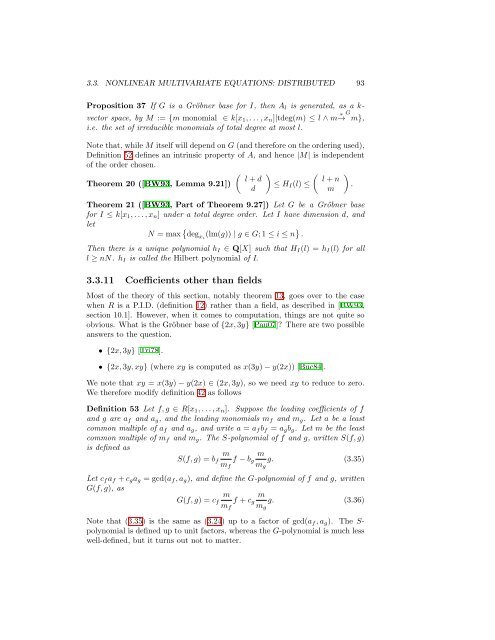Contents - Student subdomain for University of Bath
Contents - Student subdomain for University of Bath
Contents - Student subdomain for University of Bath
Create successful ePaper yourself
Turn your PDF publications into a flip-book with our unique Google optimized e-Paper software.
3.3. NONLINEAR MULTIVARIATE EQUATIONS: DISTRIBUTED 93<br />
Proposition 37 If G is a Gröbner base <strong>for</strong> I, then A l is generated, as a k-<br />
vector space, by M := {m monomial ∈ k[x 1 , . . . , x n ]|tdeg(m) ≤ l ∧ m ∗ → G m},<br />
i.e. the set <strong>of</strong> irreducible monomials <strong>of</strong> total degree at most l.<br />
Note that, while M itself will depend on G (and there<strong>for</strong>e on the ordering used),<br />
Definition 52 defines an intrinsic property <strong>of</strong> A, and hence |M| is independent<br />
<strong>of</strong> the order chosen.<br />
Theorem 20 ([BW93, Lemma 9.21])<br />
( l + d<br />
d<br />
)<br />
≤ H I (l) ≤<br />
( l + n<br />
m<br />
Theorem 21 ([BW93, Part <strong>of</strong> Theorem 9.27]) Let G be a Gröbner base<br />
<strong>for</strong> I ≤ k[x 1 , . . . , x n ] under a total degree order. Let I have dimension d, and<br />
let<br />
N = max { deg xi<br />
(lm(g)) | g ∈ G; 1 ≤ i ≤ n } .<br />
Then there is a unique polynomial h I ∈ Q[X] such that H I (l) = h I (l) <strong>for</strong> all<br />
l ≥ nN. h I is called the Hilbert polynomial <strong>of</strong> I.<br />
3.3.11 Coefficients other than fields<br />
Most <strong>of</strong> the theory <strong>of</strong> this section, notably theorem 13, goes over to the case<br />
when R is a P.I.D. (definition 12) rather than a field, as described in [BW93,<br />
section 10.1]. However, when it comes to computation, things are not quite so<br />
obvious. What is the Gröbner base <strong>of</strong> {2x, 3y} [Pau07]? There are two possible<br />
answers to the question.<br />
• {2x, 3y} [Tri78].<br />
• {2x, 3y, xy} (where xy is computed as x(3y) − y(2x)) [Buc84].<br />
We note that xy = x(3y) − y(2x) ∈ (2x, 3y), so we need xy to reduce to zero.<br />
We there<strong>for</strong>e modify definition 42 as follows<br />
Definition 53 Let f, g ∈ R[x 1 , . . . , x n ]. Suppose the leading coefficients <strong>of</strong> f<br />
and g are a f and a g , and the leading monomials m f and m g . Let a be a least<br />
common multiple <strong>of</strong> a f and a g , and write a = a f b f = a g b g . Let m be the least<br />
common multiple <strong>of</strong> m f and m g . The S-polynomial <strong>of</strong> f and g, written S(f, g)<br />
is defined as<br />
m m<br />
S(f, g) = b f f − b g g. (3.35)<br />
m f m g<br />
Let c f a f + c g a g = gcd(a f , a g ), and define the G-polynomial <strong>of</strong> f and g, written<br />
G(f, g), as<br />
m m<br />
G(f, g) = c f f + c g g. (3.36)<br />
m f m g<br />
Note that (3.35) is the same as (3.24) up to a factor <strong>of</strong> gcd(a f , a g ). The S-<br />
polynomial is defined up to unit factors, whereas the G-polynomial is much less<br />
well-defined, but it turns out not to matter.<br />
)<br />
.












![[Luyben] Process Mod.. - Student subdomain for University of Bath](https://img.yumpu.com/26471077/1/171x260/luyben-process-mod-student-subdomain-for-university-of-bath.jpg?quality=85)



